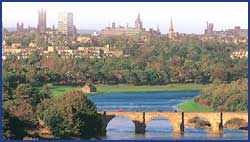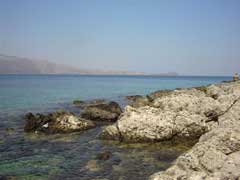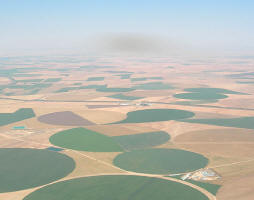 New water-based technology can help curb the impact of drought
New water-based technology can help curb the impact of drought
A technique using osmosis to turn seawater into drinking water is just one of the cool prize-winning innovations for curbing the impact of drought featured in this article.
The United Nations, which marked World Day to Combat Desertificationon 17 June, describes drought as the "world's costliest natural disaster". When monsoon rains failed to arrive in the Horn of Africa three years ago, for example, an estimated 50,000 people died. The US, Brazil and Sri Lanka are just some of the countries experiencing the impacts of low rainfall.
With climate experts predicting an increase in the frequency of droughts, policymakers and business leaders are searching for innovative ways to cope. One area of hope is water-based technologies, as this selection of prize-winning innovations reveals.
Data-driven diagnostics
Droughts may appear on weather maps as large blotches of red or yellow, depending on their general intensity, but local conditions can vary substantially. In an ideal world, farmers would know the precise water availability field by field.
Smart data-gathering technologies are beginning to make such levels of precision possible. PrecisionHawk in Indiana, for instance, has designed a small drone-like contraption that can map surface water, calculate drainage times and assess plant health from above individual fields. In California, TerrAvion offers a similar aerial mapping service, only in a real plane flown by a contract pilot.
Wellntel looks under the ground rather than above it. Recently shortlisted in the Imagine H2O's Global Water competition, the US start-up uses sonar technology to assess the depth of groundwater in wells on farms and rural houses. Farmers can use the data to assess if their wells and pumps are working efficiently, as well as to decide about appropriate irrigation systems and storage upgrades or crop rotation.
Patching leaks
Up to 30% of water is lost because of leaks or burst water pipes. Such wastage is never good, but it's extra critical in times of drought. Rather than wait for customers to complain about drops in water pressure, data-based analytics are now giving water utilities a heads-up.
One of the companies leading the charge is TaKaDu. The Israeli water tech firm offers what it calls a "software-as-a-service" solution for water utilities. Raw data from across the water distribution network is sent to TakaDu's secure server, which then pre-processes the information to detect anomalies and send real-time alerts to the relevant water operators. The system's automated algorithms correlate changes in everything from flow and pressure to reservoir levels and water quality.
Another lead detection system winning plaudits is Echologics. Winner of this year's Water Industry Achievement Awards, the Canadian firm has developed a system for detecting water loss based on sound. Developed in conjunction with Severn Trent Water and Loughborough University, the LeakFinderST "correlator" uses acoustic technologies to assess pipe conditions and pinpoint leaks.
From brine to cup
Drought or no drought, the world is not short of water. We have oceans of the stuff. The problem is its high salt content, which renders it useless for agriculture or human consumption. The idea of purifying salt water is as old as the hills, but, to date, attempts to do so have either proved ineffective or prohibitively expensive.
Oasys Water, named Water Technology Idol of the Year at the 2014 Global Water Awards in Paris, could just change that. Using natural, or forward osmosis, the US company uses a membrane-based desalination process that successfully turns salt water with a salinity level five times that of seawater into drinking water.
Unlike many other desalination systems, Oasys avoids steps such as feed water boiling and high pressure pumping, which are energy intensive. Where the process does require steam or heat (as with the heating of the thermolytic salt-based solution used to draw water across the membrane), Oasys relies on renewable sources such as solar-thermal and industrial co-generation heat rather than fossil fuels.
Efficient irrigation
One of the most visible signs of the prolonged drought in California are the thousands of acres of farmland left fallow. With farming accounting for around 70% of the world's total water consumption, even the smallest efficiency gains promise to have a substantial knock-on effect.
Drip irrigation represents one such "smart" tech solution. The Israeli firmNetafim is a long-standing pioneer in the field, introducing the world's first so-called micro-irrigation system back in 1966.
In the case of traditional overhead spray irrigation, large volumes of water are lost through evaporation and excess surface run-off, as well as through mist and overspray caused by wind. Drip irrigation avoids such wastage by applying water directly to the plant's root zone.
As well as saving water, the precision approach to irrigation promises to increase productivity as well. John Vikupitz, Netafim's US chief executive, cites a farmer in Virginia who recently harvested more than 450 bushels of corn per acre using a drip system. Average yields among US corn farmers are a mere 159 bushels per acre.
The water hub is funded by SABMiller. All content is editorially independent except for pieces labelled advertisement feature. Find out more here.
| Contact information | n/a |
|---|---|
| News type | Inbrief |
| File link |
http://www.theguardian.com/sustainable-business/water-technology-impact-drought |
| Source of information | The Guardian |
| Keyword(s) | osmosis, drought |
| Subject(s) | HYDRAULICS - HYDROLOGY , INFORMATION - COMPUTER SCIENCES , MEASUREMENTS AND INSTRUMENTATION , METHTODOLOGY - STATISTICS - DECISION AID , POLICY-WATER POLICY AND WATER MANAGEMENT , RISKS AND CLIMATOLOGY , WATER DEMAND |
| Relation | http://www.semide.net/topics/WaterScarcity |
| Geographical coverage | n/a |
| News date | 19/06/2014 |
| Working language(s) | ENGLISH |
 you are not logged in
you are not logged in





